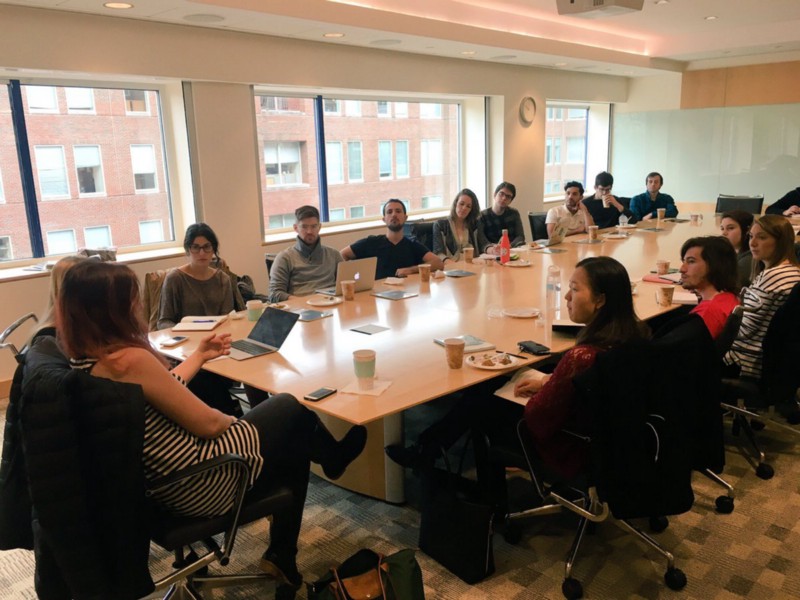When it comes to product, Ellen Chisa, VP of Product at Lola, is a pro. Ellen began her product career at Microsoft as a Program Manager for the Office Hub on Windows Phone 8. She built her product expertise at Kickstarter, where she created their advanced search functionality, activity feed and backer history, and preview comments system. Today, Ellen is the VP of Product at personal travel service, Lola. An early member of the Lola team, Ellen has focused on building out their first public product, the iOS app.
Last month at Rough Draft Ventures, we gathered our founders for breakfast with Ellen Chisa to uncover best practices for building successful, scalable products.
Here’s a summary of what we learned:
First time founders should be responsible for product decisions from the start
Ellen believes that the product vision and management should be tied to one of the founders initially. It’s hard to have two product people on the same team. At the end of the day, someone has to make the call for the product direction. It can be the technical founder, or the non-technical founder. Furthermore, Ellen suggests not to hire out the product role until the founder cannot do it anymore. A team might be able to take on 5–10 engineers before the founder can no longer manage the entire process. The head of product is the person a founder hires when he or she can no longer scale.
Gather in-person feedback on your beta
With the Lola beta, Ellen brought 12 people into the office to sit and use all functionalities of the app. By sitting with these users in person, Ellen and her team learned that a lot of classic features were missing such as copy and paste for basic functioning and booking, and that users often preferred a microphone rather than a keyboard to make bookings.
You’ll never feel like you’re ready to launch
Ellen advised us that product should be launched as soon as founders have a minimum output they’re proud of. First time founders are never going to feel ready. Ellen tells founders to ask themselves: Will I actually learn something from shipping this? Will it actually solve someone’s problem? If so, ship it.
Your launch announcement should be tied to something happening in the world
Gone are the days when people scrolled through TechCrunch to read about and try the newest product. A better approach is to tie the product to something happening in the real world. At Lola, Ellen and her team were excited about the conversation around conversational commerce. They took a contradictory stance that while technology is making huge advancements, humans still need to play a role where technology cannot. This is the narrative they told at launch.
A good product person is good at saying no
A good product person is inherently curious, does whatever project needs getting done, is good at listening to all of the possible opportunities, is open minded, yet good at saying no. It’s up to the product person to say “no, we can’t do that but we are going to do this and here’s why.” A good question to ask when hiring a product person is what is one feature they could add and take away from the last product they built, and if they could start over again, what they would do differently. This prompts a healthy conversation about how the product relates to the entire business.
It is okay if the product person is non-technical
Ellen suggests that having a technical product leader is not absolutely necessary. A good parallel is that most people don’t require product leaders to be good at design or good at business. As long as they have a strong understanding of how the product is built and how to work with the engineers, a product leader does not need a technical background.
Acquire new users like you don’t have a marketing team
Today, people don’t generally scroll through the App Store looking for the top app to download. Instead, downloading an app usually happens through word of mouth. Ellen suggests thinking about acquiring users by acting as if you don’t have a marketing team. It’s about getting users you have to bring you more users. Think about the features to put in the product that will actually make it better for publicly sharing, such as Uber’s ride splitting function.
Don’t add a new coat of paint to a feature no one is using
Ellen suggests that incremental improvements aren’t going to get you to where you need to go. If no one is using a feature, putting a new coat of paint on it is not going to help. A change is worth it if everyone is using this feature and the change will bring 100% more users. Think about the impact of what you are building rather than the type of feature is it.
Send out a monthly product roadmap to keep everyone on the same page
In her experience, Ellen has seen founders get excited about what they are creating, build it, and ship it right away. Afterwards, they realize the rest of their team is suddenly forced to interact with customers using a new feature they didn’t know existed. To solve for this, Ellen sends a roadmap to the team at the start of every month. It explains which engineers are working on what features, what complicated features there are, how people are resolving those complications, and what new features are soon to launch. Ellen found this gives greater visibility to everyone on the team and enhances communication around upcoming changes.
We’re thrilled to have spent time learning from Ellen, and are looking forward to following the work she leads at Lola!
Natalie Bartlett is an Associate at General Catalyst and Marketing & Portfolio at Rough Draft Ventures. Follow Natalie on Twitter: @Np_bartlett.

